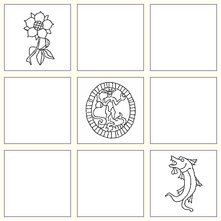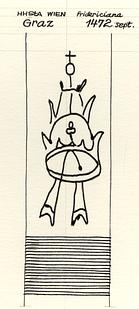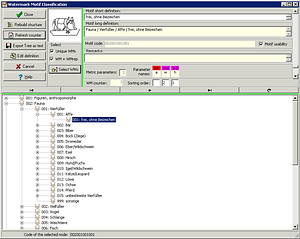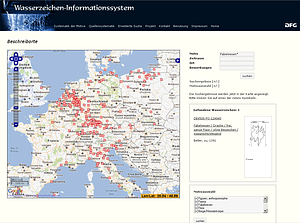
 Watermark-collage of frontpage |
Since 1 February 2010 the Deutsche Forschungsgemeinschaft (DFG – German Research Foundation) has been sponsoring the development of a joint information system for watermarks within its manuscript departments. The first phase ended on 31 January 2012; however, an application to continue funding the project for another period of two years was approved in April 2012.
Both national and international partners are part of this cooperation project. The first phase saw the participation of the Landesarchiv Baden-Württemberg (LABW), the Württembergische Landesbibliothek (WLB) Stuttgart, the Bayerische Staatsbibliothek München (BSB), the Universitätsbibliothek Leipzig (UBL) as well as the Kommission für Schrift- und Buchwesen an der Österreichischen Akademie der Wissenschaften an der Österreichischen Akademie er Wissenschaften in Vienna (ÖAW). Two further partners joined in the second phase: the Die Staatsbibliothek zu Berlin (SBB) -Manuscript Department and the Deutsche Nationalbibliothek in Leipzig (DNB) with its large collection of watermarks of the German Book and Script Museum (Deutsches Buch- und Schriftmuseum).
Informationen und Kontaktadressen der einzelnen Partner:
 Rubbing |
The project aims at establishing a common watermark information system which will allow the decentralized entering of digitalized representations of watermarks together with their metadata such as motif, place of description, manuscript containing them etc. . The system creates standards for the development and maintenance of a digital watermark collection and makes it available for scientific purposes by means of a centralized Internet access. As part of the project a testing module for the decentralized data input was first implemented using already existing software from the Austrian Academy of Science (Österreichische Akademie der Wissenschaften) – the so-called “watermark toolkit” (Victor Karnaukhov) previously also used in the highly regarded EU project Bernstein and adapting it to the requirements of German manuscript centres.
Common exploitation standards and a hierarchical classification system form the basis of a homogenous development; implementing multilingual terminology appeals to international users.
 Betaradiography |
For Internet presentation a freely accessible online presentation system has been developed by building on the already existing frontend of "Piccard-Online" and by adding extra features to allow for geographic visualization. Approximately 103,000 digitalized images of watermarks and their significant data have so far been collected under the Internet address www.wasserzeichen-online.de. Entering into the second phase of the project, a further 28,000 examples will be included from so far untapped collections. Homogenous exploitation as well as continuous additions are turning the WZIS into a central database for watermark research.
 Finished artwork |
This joint exploitation has far-reaching potential, because knowledge of watermarks alongside manuscripts, plays an integral part in the humanities, e.g. in the study of philology, history, art history, musicology and the study of books. In addition, the study and interpretation of watermarks provide important advances in knowledge in the fields of restoration and Antiques. The database is able to pave the way beyond narrow subject matters and institutions for a deeper interdisciplinary understanding of problems relating to identifying, documenting and evaluating watermarks.
Besides the identification of new watermarks, the more than 90,000 data items of the “Piccard-online” application have been integrated. Provision is also made to incorporate the digitalized watermarks of the printed Piccard volumes 3-17. Both originate from the Gerhard Piccard’s watermark collection which is the largest of its kind in the world.
 Original copy |
The DFG project’s application for continuation, granted in April 2012, envisages not only new collaborators, but also substantial expansion in its objectives, as well as some technical innovations. A considerable gain in quality will be achieved and new standards will be set by including paper samples up to the Modern Era.
In addition to the presentation of data in the frontend of the information system, referencing options to external databases such as Medieval Watermarks or Manuscripta Mediaevalia are possible. The watermark information system can therefore act as an aggregator.
 Classification |
Technical enhancements make it possible to store several pieces of digitized information for each watermark, e.g. watermark and countermark, fragments and the results of different recording formats. Schemes of exact positioning can be uploaded to give the user a better overview of the manuscripts. Geographical information will be completed by the referencing of paper mills. A word list should render it possible when dealing with complex motifs to describe the watermarks and their components independently of their classification, thus facilitating their research. The project’s multilingualism will be considerably expanded with regard to classification and word list, as well as the frontend.
 Map |